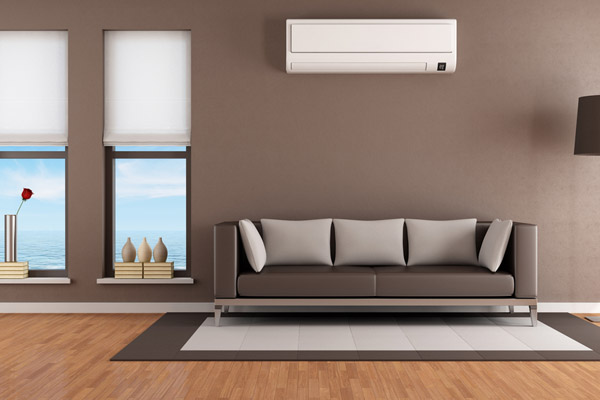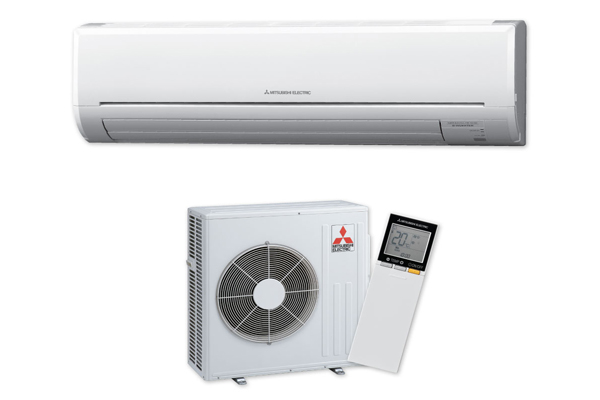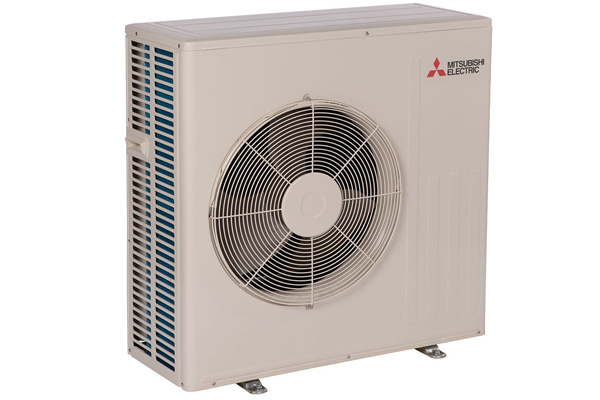
A zoned mini-split system offers better control of your environment, allowing you to manipulate the temperatures in different rooms or zones independently. Ductless mini-split systems have two main components: the indoor air-handler and the outdoor compressor or condenser. A conduit connects these two components through a small, three-inch hole in the wall.
HVAC experts often recommend mini-split systems for whole homes and new constructions. For example, if you have plans to build a new room or enclosed area in your home and cannot add ductwork, a mini-split system is a perfect choice. Also, many homeowners use them in conjunction with their central HVAC system as a way to reduce their home heating and cooling costs. They install indoor air handlers in the rooms of the home that are frequently in use. This way, they can operate their central system less, consequently, paying less on their energy costs. Ductless systems offer an efficient, cost-effective, and flexible way of home heating and cooling. This explains why mini-split systems are increasingly becoming popular among homeowners.
How To Create A Ductless Multi-Zone Setup
A mini-split system has several features that make it an attractive choice. The features may seem overwhelming at first, but don’t worry. Use our three-step guide to learn how to create your own zoned mini-split ductless system.
Step No. 1: Know The Ductless Size Or Capacity Your Home Requires
Before you go out to purchase a ductless HVAC system, you need to determine the size or capacity that your home needs. Size refers to the ability of the HVAC system to remove heat, measured in BTU or British Thermal Unit. BTU refers to how much heat is required to increase by 1°F the temperature of 1 lb. of water. The better the BTU rating, the more efficient the system is.

Mini-Split Sizing
It is important to ensure that your ductless system is the right size. This is the only way that it can generate enough heat to warm or cool your home efficiently. A mini-split with a higher BTU or a bigger tonnage can provide better heating and cooling. A higher BTU or capacity can also heat and cool larger rooms efficiently. Let’s say you have a room or enclosed space that has an area of 150-250 sq.feet. To heat or cool this space efficiently, you would need a mini-split system that has 6,000 BTUs. If you have a bigger space, say, 1,400-1,500 sq.ft. in area, you will require a system that has 24,000 BTUs. The larger the area, the larger the capacity of the mini-split should be.
The problem with improperly-sized ductless systems is that they are more likely to show problems prematurely. If the mini-split is too small for your home, you will waste energy. The system will operate continuously, but it cannot maintain a good temperature to keep your home comfortable. You are also more likely to experience warm or cool spots in your home.
If, however, the system is too big, it will short cycle. This is a malfunction wherein the HVAC system turns off and on repeatedly. It will also cost more to use and have an increased likelihood to fail prematurely.
To avoid these problems, you need to ensure that your mini-split system is the right size. If it is improperly sized, the system (and you) will suffer from lower efficiency, increased service costs, premature failure, and decreased home comfort. Ask a trusted and licensed HVAC technician to help you find the right-sized ductless HVAC system for your home.
Nominal Vs. Actual
One important component of the HVAC system is the condenser. In the factory, it is subjected to a performance test to determine its size. The test is performed under ideal conditions in the factory to obtain what is known as the nominal capacity rating. This figure will give you a good idea about the size and capacity of specific condensers.
There is just one concern, however. The conditions in the factory are not the same as those in the real world. The indicator of how a condenser will perform is called the actual capacity rating. Of course, the manner with which a mini-split performs will ultimately depend on many factors, such as line-set length, installation variations, outdoor temperature, and humidity, among others. These will all impact the actual experience.
Mini-split systems will work harder during extreme weather conditions. If you need to choose a size for an HVAC system for a room that is in-between sizes, make sure to choose one that is a size higher. This will make sure that the system will remain efficient and effective.
Step No. 2: Choose A Ductless Condenser
Once you have an idea about the proper sizing or capacity of your HVAC system, you need to know the right condenser type for your home. If your goal is to create multiple zones, you will require a condenser that comes in two types: the branch box type and the multi-port type.
Branch Box Type
The branch box type connects the condenser to the indoor air handler. This type is used for high-capacity outdoor units, particularly those that utilize condensers that can handle as many as eight zones. Branch boxes allow just one conduit to the condenser. This is enough to supply the right amount of coolant to multiple indoor air handlers. You can even increase the number of zones by simply connecting two branch boxes. With two units in place, some mini-split systems can cool or heat as many as nine zones.
It is good to note that branch box combinations tend to be manufacturer-specific. As such, a condenser can only be used with certain combinations of branch boxes. If you choose a branch box, always ask an HVAC professional for advice to ensure that you select the correct type.
Multi-Port
Multi-ports are all-in-one condensers that have built-in refrigerant ports. The ports provide connections between indoor units and outdoor units. Multi-ports are also quite easy to use. With a multi-port condenser, you can enjoy multiple zones that you can control independently without requiring additional pipe connections.
Multi-port condensers are more affordable than branch boxes. They do, however, have a few disadvantages. They have limited capacity, for example, there are fewer available line-set lengths, and they have reduced flexibility. If you choose a multi-port condenser, you will have to deal with multiple line sets in your backyard. Some homeowners may find this unappealing aesthetic-wise.
Branch Boxes Versus Multi-Port
Both branch box and multi-port types have advantages and limitations. Multi-port condensers, for example, are comparatively easier to install because they require fewer parts and labor. These condensers can handle as many as five zones in a single home. Multi-ports also have lower BTU capacity and require longer line-set runs.
Branch boxes come with a higher BTU capacity. They are also more flexible compared to a multi-port, allowing you to create as many as nine zones. However, branch boxes are more complex than multi-ports and will require more parts and more intricate installation.
If you cannot make up your mind between these two condenser types, try to check them out for yourself and compare them closely. That way, you will determine which type offers the most advantage for your home.

Step No. 3: Pick the Indoor Air Handler
The last step you need to do to create your zoned mini-split is choosing the indoor unit. There are different types that can meet your different needs. Here are the types of indoor air handlers available:
Wall-Mounted Ductless Indoor Air Handlers
Wall-mounted air handlers are the most common type of air handling units. It is the most affordable type, efficient, and easiest to install. Because it is so popular, it is available in different sizes, types, and efficiency ratings.
Wall-mounted units are installed on a wall. For its connection to the connecting wire, drain tube, and refrigerant lines, the wall-mounted type will need a small, three-inch hole drilled through the wall. It is best for rooms that have no high windows and have wide walls.
Floor-Mounted Ductless Systems
Floor-mounted air handling units are installed against the wall near the floor, about six inches or so from the floor surface. These types of units are best for rooms with minimal wall space or those with windows that are too high. They are the recommended solution for enclosed spaces where ceilings are slanted or too low.
Ceiling Cassette Ductless Units
The ceiling cassette unit is installed in the ceiling. If you have a drop-type or T-bar ceiling, this is a perfect choice. It can be installed on joist ceilings or drywall as long as there is sufficient space between the joists. Once the ceiling cassette unit is installed, the only visible component of the system will be the grilles. As such, you can enjoy heating and cooling without bulky indoor components that take up space.
Concealed Duct Indoor Air Handling Units
The concealed duct type offers a concealed and very flexible solution for those who prefer to have an air handling unit that is out of sight. The indoor air handler is mounted out of the zone and conditioned air passes through grilles – the only component of the system that will be visible. Concealed units combine the features of a ductless mini-split and a conventional central forced-air system. It is so flexible that it can be installed in small spaces such as the attic, a closet, or a crawlspace. It delivers cool or warm air via the ductwork.
Concealed duct units are out of sight, making them the best option if you want to preserve the appearance of a room. They save space and are a good choice if you cannot install a ceiling cassette air handling unit in your ceiling. The only downside is that they do not carry a high-efficiency rating.
Ceiling-Suspended Ductless Units
An HVAC technician will place a ceiling-suspended indoor unit onto the ceiling. They can also hang them below the ceiling level using threaded rods. The rods are necessary in case other appliances are installed on the ceiling with the air handling unit. Since these appliances block the airflow from the air handling unit, the threaded rods help prevent the obstruction. Ceiling-suspended units should be eight feet or more from the floor surface and should be installed against the wall.
Final Thoughts
Now that you have an idea about the right steps to take to choose your zoned mini-split system, it is time to make your home a much more comfortable place. If you still have questions and clarifications, don’t hesitate to call a licensed HVAC technician for advice. A trained professional can help you put together the best system that will keep your home comfortable and energy-efficient.
Check Out One Of Our Ductless Installation Projects
Mitsubishi Ductless Installation Project In Rocky Hill, New Jersey
Call PFO Heating & Air Conditioning For More Information About Ductless HVAC Systems

For all your HVAC system needs, call PFO Heating & Air Conditioning today. Our technicians are all NATE-certified, and they have a great deal of experience. They’ll also determine what your home comfort needs are and determine the best and most affordable solutions to meet them.
As a full-service HVAC company, PFO Heating & Air Conditioning offers an array of HVAC services. This includes heating and cooling installations, tuneups, repairs, and much more. We offer free, in-home consultations. Call now to schedule an appointment.
Click here to contact us now or call us at (800) 253-9001 to find out more!
The post Best Ways To Create A Zoned Mini-Split System appeared first on PFO Heating & Air Conditioning.
from PFO Heating & Air Conditioning https://www.princetonfuel.com/blog/zoned-mini-split-system/
via IFTTT
thanks for sharing it
ReplyDeleteair conditioner
air conditioner price in pakistan
haier air conditioner
ac price in pakistan
ac